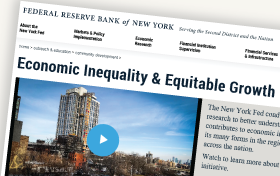The Low Volatility Puzzle: Is This Time Different?

As stock market volatility hovers near all-time lows, some analysts are questioning whether investors are complacent, drawing an analogy to the lead-up to the financial crisis. But, is this time different? We follow up on our previous post by investigating the persistence of low volatility periods. Historically, realized stock market volatility is persistent and mean-reverting: low volatility today predicts slightly higher, but still low, volatility one month and one year from now. Moreover, as of mid-September, the market is pricing implied volatility of 19 percent in one to two years’ time. This level contrasts with the pre-crisis period when the term structure of implied volatility was relatively flat, which suggests this time may indeed be different, at least as measured by market participants’ pricing of risk.
The Low Volatility Puzzle: Are Investors Complacent?

In recent months, some analysts and policymakers have raised concerns about the unusually low level of stock market volatility. For example, in the June Federal Open Market Committee (FOMC) minutes “a few participants expressed concern that subdued market volatility, coupled with a low equity premium, could lead to a buildup of risks to financial stability.” In this post, we review this concern and find the evidence on investor complacency is mixed. On one hand, we present a view suggesting that historical volatility may have been abnormally high, rather than current volatility being abnormally low. On the other hand, we find that estimates of the volatility risk premium are somewhat low, which is consistent with the view that investor risk tolerance has increased. We extend this analysis in a related post publishing on Wednesday.














 RSS Feed
RSS Feed Follow Liberty Street Economics
Follow Liberty Street Economics